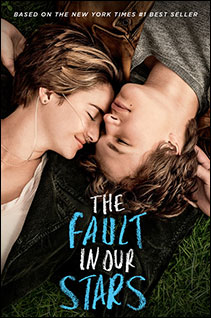 Last July at West Elmira Library our staff member, Ahnece, and two of our patrons, Mary Ann and Claire, wrote a review article about the book The Fault in Our Stars. This summer Ahnece, Mary Ann, and Claire all went to see the popular new movie based on the book they all loved so much. Was the movie as good as the book? Let’s find out… (warning: may contain spoilers)
Last July at West Elmira Library our staff member, Ahnece, and two of our patrons, Mary Ann and Claire, wrote a review article about the book The Fault in Our Stars. This summer Ahnece, Mary Ann, and Claire all went to see the popular new movie based on the book they all loved so much. Was the movie as good as the book? Let’s find out… (warning: may contain spoilers)
Ahnece- “The vast difference between reading the book and watching the movie was quite enlightening. I have always surmised that movies rarely do justice to a book however, after viewing A Fault in Our Stars, there is no question in my mind that this is true.
My review of reading the book was completely uplifting, positive, and enjoyable. However, when I was at the movie, my heart was wrenched and spent most of my time there in tears. I experienced two entirely different emotions between reading the book and watching the movie. I feel that even a bad rendition of the movie could have still been possible and I now understand why an author can refuse the movie rights to their books.”
Mary Ann- “John Green’s novel The Fault in Our Stars is a gem which conveys so much sadness yet is never maudlin. Can the movie touch us with the same empathy and sense of futility?
First of all, we must realize what books do well. They probe the inner being of the characters and reveal those qualities of heart and mind that place them in our universe. Movies also do this, but heighten and amplify the author’s setting where the characters play out the drama of their lived. A skillful director can enhance setting with camera angles and use of lighting. Brilliant actors can convey the inner character through expression and gesture. They can capture emotion.
The movie The Fault in Our Stars captures the futility, grace, grandeur and depth of the lives of Hazel and Gus. The director augments their skill with the use of music and electronics, especially their iPhones which allow them to be connected even when they are apart. They also enable them to become acquainted.
Through music we can experience tenderness, guarded optimism, their anticipation and delight about their trip to Amsterdam, the romance and fleeting pleasure of their dinner with Classical violin music. When Hazel struggles to climb the stairs to Anne Frank’s attic, the music and Anne’s voice-over add to our admiration and certain hopelessness. When Gus is dying, music replaces dialogue. Their love is connected- a look transmits all feeling. We know that Peter Van Houten’s book stops mid-sentence with no resolution. Gus’s life ends the same way.
Music helps to convey that “the world is not a wish-making factory” their dreams futile but beautiful.
Claire- Comparing books and movies are like comparing pears and peaches. In my opinion, the book is always better than the movie, however, The Fault in Our Stars came very close. I enjoyed how the movie used much of the same dialogue and wording as the book, especially the popular quotes. “There were several characters and parts that were left out of the film, however, the theme rang true”, said my friend Katie Ronsivalle. My favorite parts of the movie were the Easter eggs hidden throughout. For example, Hazel and Augustus both had “The Hectic Glow” posters in their room, and Requiem for Mayhem could be seen on Hazel’s nightstand. Overall, the movie mimicked the book almost perfectly, but no matter how you look at it, the book was better.
Stop in and let us know what you thought of the movie! Also, check out our new YA book club or ask us what the Adult book club selection is reading this month.
